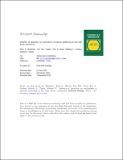Files in this item
Influence of glaciation on mechanisms of mineral weathering in two high Arctic catchments
Item metadata
| dc.contributor.author | Hindshaw, Ruth | |
| dc.contributor.author | Heaton, Tim H.E. | |
| dc.contributor.author | Boyd, Eric S. | |
| dc.contributor.author | Lindsay, Melody L. | |
| dc.contributor.author | Tipper, Edward Thomas | |
| dc.date.accessioned | 2016-11-12T00:33:50Z | |
| dc.date.available | 2016-11-12T00:33:50Z | |
| dc.date.issued | 2016-01-20 | |
| dc.identifier | 230453032 | |
| dc.identifier | db6cbd91-a0e1-4d10-a067-81fd6bbbef0e | |
| dc.identifier | 84946949956 | |
| dc.identifier | 000366652200004 | |
| dc.identifier.citation | Hindshaw , R , Heaton , T H E , Boyd , E S , Lindsay , M L & Tipper , E T 2016 , ' Influence of glaciation on mechanisms of mineral weathering in two high Arctic catchments ' , Chemical Geology , vol. 420 , pp. 37-50 . https://doi.org/10.1016/j.chemgeo.2015.11.004 | en |
| dc.identifier.issn | 0009-2541 | |
| dc.identifier.other | RIS: urn:5B45F8C8CF4D44D2013D4B57178112D6 | |
| dc.identifier.uri | https://hdl.handle.net/10023/9811 | |
| dc.description | This project was funded by a Swiss National Science Foundation fellowship for prospective researchers PBEZP2-137335 and a Marie Curie Intra-European Fellowship (PIEF-GA-2012-331501) to RSH. Fieldwork was supported by an Arctic Field Grant 219165/E10 (The Research Council of Norway) to RSH. ESB acknowledges support for this work from NASA (NNA15BB02A and NNA13AA94A). | en |
| dc.description.abstract | Abstract In order to investigate the effect of glaciation on mineral weathering, the stream water chemistry and the bacterial community composition were analysed in two catchments containing nominally identical sedimentary formations but which differed in the extent of glaciation. The stream waters were analysed for major ions, δ34S, δ18OSO4 and δ18OH2O and associated stream sediments were analysed by 16S rRNA gene tagged sequencing. Sulphate comprised 72–86% and 35–45% of the summer anion budget (in meq) in the unglaciated and glaciated catchments respectively. This indicates that sulfuric acid generated from pyrite weathering is a significant weathering agent in both catchments. Based on the relative proportions of cations, sulphate and bicarbonate, the stream water chemistry of the unglaciated catchment was found to be consistent with a sulphide oxidation coupled to silicate dissolution weathering process whereas in the glaciated catchment both carbonates and silicates weathered via both sulfuric and carbonic acids. Stable isotope measurements of sulphate, together with inferences of metabolic processes catalysed by resident microbial communities, revealed that the pyrite oxidation reaction differed between the two catchments. No δ34S fractionation relative to pyrite was observed in the unglaciated catchment and this was interpreted to reflect pyrite oxidation under oxic conditions. In contrast, δ34S and δ18OSO4 values were positively correlated in the glaciated catchment and were positively offset from pyrite. This was interpreted to reflect pyrite oxidation under anoxic conditions with loss of S intermediates. This study suggests that glaciation may alter stream water chemistry and the mechanism of pyrite oxidation through an interplay of biological, physical and chemical factors. | |
| dc.format.extent | 1381881 | |
| dc.language.iso | eng | |
| dc.relation.ispartof | Chemical Geology | en |
| dc.subject | Chemical weathering | en |
| dc.subject | Pyrite | en |
| dc.subject | Sulphur isotopes | en |
| dc.subject | Bacteria | en |
| dc.subject | Biogeochemical cycles | en |
| dc.subject | QE Geology | en |
| dc.subject | DAS | en |
| dc.subject.lcc | QE | en |
| dc.title | Influence of glaciation on mechanisms of mineral weathering in two high Arctic catchments | en |
| dc.type | Journal article | en |
| dc.contributor.sponsor | European Commission | en |
| dc.contributor.institution | University of St Andrews. Earth and Environmental Sciences | en |
| dc.contributor.institution | University of St Andrews. St Andrews Isotope Geochemistry | en |
| dc.identifier.doi | 10.1016/j.chemgeo.2015.11.004 | |
| dc.description.status | Peer reviewed | en |
| dc.date.embargoedUntil | 2016-11-11 | |
| dc.identifier.grantnumber | PIEF-GA-2012-331501 | en |
This item appears in the following Collection(s)
Items in the St Andrews Research Repository are protected by copyright, with all rights reserved, unless otherwise indicated.

